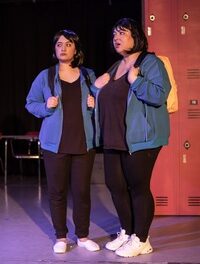Dances, Songs, Inventions. Dez Cordas: Craig Butterfield, double bass, Matthew Slotkin, guitar; CRC 3020, ©2009, 58:08, $16.00. Centaur Records.
While this is a fairly common instrument pairing, or pair combined with yet other instruments, in the jazz and popular music worlds, it is about as rare as it gets in classical music. Indeed, it is so rare that, according to the notes in the booklet, the repertoire is non-existent, so these musicians have had to arrange pieces for other pairs of instruments, mostly involving flute, strings, piano, or voice, to create one for themselves. The arrangement of each piece was generally made by the musician whose instrument carries the melody, or, in some cases, jointly by both when the work was for a single keyboard instrument.
The works performed (in alphabetical, not playlist order) are: J.S. Bach’s Two-Part Inventions (Nos. 4, 6, 12, and 13), Chick Corea’s Children’s Songs (Nos. 3, 6, and 7), Reinhold Glière’s Suite for Guitar and Double Bass (adapted from his duets for violin and cello), Adolph Mišek’s “Concert-Polonaise,” Astor Piazzolla’s L’Histoire du Tango (Nos. 1-3), and “Libertango,” and the Aria from Heitor Villa-Lobos’ Bachianas Brasileiras No. 5.
While the pairing may be rare, it is extremely well balanced and musically very pleasing. It is enjoyable to savor the variety in the arrangements as each instrument in turn carries the melody while the other supplies the basso continuo, rather than the double bass always playing that role, and to listen to the variety of sound-producing techniques, some of them percussive. While a repertoire may be non-existent, these arrangements are quite successful. Their success ought to encourage these musicians to arrange other works – yet more of Bach’s Two-Part Inventions springs immediately to mind! – as well as other arrangers, composers, and musicians to expand the repertoire with both adaptations and original works. It occurs to me that there might be some early music for lute and/or viola da gamba that would be somewhat equivalent, and therefore easy to arrange, and that the duo might want to explore that realm for some ideas to widen its horizons for future adaptations, performances, and CD releases.
There is a contemporary trend to perform classical music in non-traditional settings such as clubs that are more familiar territory for jazz, folk, and pop groups (Am I perceiving an attempt to ensure the inclusion of classical music in Darwin’s ‘survival of the fittest’ here? Do I detect a different manifestation of the “Switched-On Bach” phenomenon?). This pairing and music offer a golden opportunity to participate in this trend (since regular audiences in those settings are already accustomed to the presence of these instruments), to entertain, subliminally proselytize to, and perhaps convert the younger generations.
The accompanying booklet is the epitome of simplicity. It contains concise joint notes by the musicians about each work and its composer together with their own bios. Butterfield is on the faculty of USC in Columbia; CVNC reviewed a 2009 concert at Duke that included Slotkin. The track listings and instrument info appear on its outside cover as well as on the outside of the tray card. There are virtually no art work or photos anywhere; the front cover is solid black with white text and three vertical white lines of unequal length suggesting strings on the right side and with the manufacturer’s logo in the lower left corner (as well as on the upper right corner of the track listings pages); its red background constitutes the only color found anywhere. The entire production is classy, harking back to the early days of record merchandising, allowing the music to speak for itself without any glamour or glitz, and it speaks eloquently.
Recommended.












